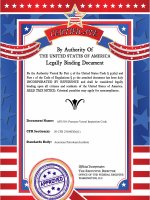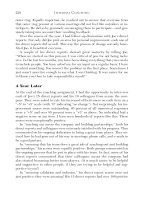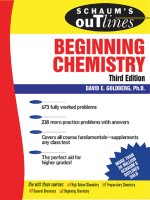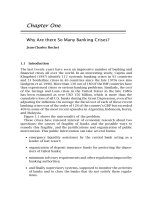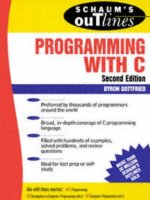portable appliance testing in service inspection and testing of electrical equipment second edition pdf
Bạn đang xem bản rút gọn của tài liệu. Xem và tải ngay bản đầy đủ của tài liệu tại đây (1.21 MB, 80 trang )
PAT: Portable Appliance Testing
www.TechnicalBooksPdf.com
By the same author
Electrical Installation Work, ISBN 978-0-7506-8733-1
Electric Wiring: Domestic, ISBN 978-0-7506-8735-5
Wiring Systems and Fault Finding, ISBN 978-0-7506-8734-8
17th Edition IEE Wiring Regulations: Explained and Illustrated,
ISBN 978-0-7506-8720-1
17th Edition IEE Wiring Regulations: Design and Verification
of Electrical Installations, ISBN 978-0-7506-8721-8
17th Edition IEE Wiring Regulations: Inspection, Testing and
Certification, ISBN 978-0-7506-8719-5
www.TechnicalBooksPdf.com
PAT: Portable Appliance Testing
In-Service Inspection and Testing of
Electrical Equipment
Second edition
Brian Scaddan, IEng, MIET
AMSTERDAM • BOSTON • HEIDELBERG • LONDON •
NEW YORK • OXFORD • PARIS • SAN DIEGO •
SAN FRANCISCO • SINGAPORE • SYDNEY • TOKYO
Newnes is an imprint of Elsevier
www.TechnicalBooksPdf.com
Newnes is an imprint of Elsevier
Linacre House, Jordan Hill, Oxford OX2 8DP, UK
30 Corporate Drive, Suite 400, Burlington, MA 01803, USA
First published 2000
Revised edition 2003
Second edition 2008
Copyright © 2008, Brian Scaddan. Published by Elsevier Ltd. All rights reserved
The right of Brian Scaddan to be identified as the author of this work has been
asserted in accordance with the Copyright, Designs and Patents Act 1988
No part of this publication may be reproduced, stored in a retrieval system or
transmitted in any form or by any means electronic, mechanical, photocopying,
recording or otherwise without the prior written permission of the publisher
Permissions may be sought directly from Elsevier ’s Science & Technology
Rights Department in Oxford, UK: phone (+44) (0) 1865 843830; fax (+44) (0)
1865 853333; email: Alternatively you can submit your
request online by visiting the Elsevier web site at />and selecting Obtaining permission to use Elsevier material
Notice
No responsibility is assumed by the publisher for any injury and/or damage to
persons or property as a matter of products liability, negligence or otherwise, or
from any use or operation of any methods, products, instructions or ideas
contained in the material herein
British Library Cataloguing in Publication Data
Scaddan, Brian
PAT : portable appliance testing : in-service inspection
and testing of electrical equipment. – Rev. ed.
1. Electric apparatus and appliances – Testing 2. Electric
apparatus and appliances – Testing – Problems, exercises,
etc.
I. Title
621.3’1042’0287
Library of Congress Control Number: 2008926543
ISBN: 978-0-7506-8736-2
For information on all Newnes publications
visit our website at www.elsevierdirect.com
Typeset by Charon Tec Ltd., A Macmillan Company. (www.macmillansolutions.com)
Printed and bound in Slovenia
08 09 10 11
11 10 9 8 7 6 5 4 3 2 1
www.TechnicalBooksPdf.com
To Nicola
www.TechnicalBooksPdf.com
This page intentionally left blank
www.TechnicalBooksPdf.com
Contents
PREFACE ............................................................................................. ix
CHAPTER 1 Legislation ........................................................................1
The Health and Safety at Work etc. Act 1974..........................................1
The Management of Health and Safety at
Work Regulations 1999 ......................................................................1
The Provision and Use of Work Equipment Regulations 1998 .................1
The Electricity at Work Regulations 1989 ............................................... 2
Prosecutions ..........................................................................................3
CHAPTER 2 Setting Up .........................................................................5
Equipment Register .............................................................................. 7
Combined Inspection and Testing Form ................................................ 7
Faulty Equipment and Repair Register ................................................ 10
CHAPTER 3 Equipment to be Inspected and Tested ............................11
Basic Protection ................................................................................. 11
Fault Protection ................................................................................... 11
Class 0 Equipment or Appliances .........................................................12
Class 01 Equipment or Appliances .......................................................12
Class I Equipment or Appliances .......................................................... 12
Class II Equipment or Appliances .........................................................13
Class III Equipment or Appliances ........................................................ 15
Equipment Types .................................................................................16
CHAPTER 4 Inspection .......................................................................19
User Checks ........................................................................................19
Formal Visual Inspection ...................................................................... 20
vii
www.TechnicalBooksPdf.com
viii Contents
CHAPTER 5 Combined Inspection and Testing .................................. 23
Testing ................................................................................................23
Preliminary Inspection ......................................................................... 23
APPENDIX 1 Shock Risk ....................................................................35
Electric Shock .................................................................................... 35
Basic Protection .................................................................................. 37
Fault Protection ................................................................................... 37
What Is Earth and Why and How We Connect to It? ..............................38
APPENDIX 2 Basic Electrical Theory Revision ....................................43
Electrical Quantities and Units ............................................................. 43
Relationship Between Voltage, Current and Resistance ........................44
Common Multiples of Units ..................................................................44
Resistance in Series ........................................................................... 44
Resistance in Parallel ..........................................................................45
APPENDIX 3 Sample 2377 Questions .................................................49
The Management of Electrical Equipment Maintenance .......................49
Inspection and Testing of Electrical Equipment ..................................... 59
APPENDIX 4 Answers to Sample 2377 Questions .............................. 67
The Management of Electrical Equipment Maintenance ...................... 67
Inspection and Testing of Electrical Equipment ................................... 67
INDEX ................................................................................................ 69
www.TechnicalBooksPdf.com
Preface
The introduction of The Electricity at Work Regulations (EAWR)
1989 prompted, among many other things, a rush to inspect and
test portable appliances. The Regulations do not require such
inspecting and testing, nor do they specifically mention portable
appliances. They do, however, require any electrical system to be
constructed, maintained and used in such a manner as to prevent
danger, and in consequence inspection and testing of systems (portable appliances are systems) is needed in order to determine if
maintenance is required.
All electrical equipment connected to the fixed wiring of an installation will need attention, not just portable appliances. I have however left the title of this book as PAT: Portable Appliance Testing as
such words are now indelibly imprinted on our minds, even though
it should read ‘Inspection and Testing of In-service Electrical
Equipment’.
The book is intended for those who need be involved in this
inspection and testing process, either as a business venture or as an
‘in-house’ procedure to conform with the EAWR. It is also a useful reference document for anyone embarking on a City & Guilds
2377 course.
Brian Scaddan, April 2008
This new edition has been updated in line with the 17th Edition
Wiring Regulations and the 3rd edition of the Code of Practice for
In-Service Inspection and Testing of Electrical Equipment.
ix
www.TechnicalBooksPdf.com
x Acknowledgements
Acknowledgements
I would like to thank Paul Clifford for his thorough technical proof
reading.
www.TechnicalBooksPdf.com
CHAPTER 1
Legislation
There are four main sets of legislation that are applicable to the
inspection and testing of in-service electrical equipment:
☞ The Health and Safety at Work etc. Act (HSWA) 1974
☞ The Management of Health and Safety at Work Regulations
(MHSWR) 1999, amended 2003
☞ The Provision and Use of Work Equipment Regulations
(PUWER) 1998, amended 2002
☞ The Electricity at Work Regulations (EAWR) 1989.
THE HEALTH AND SAFETY AT WORK ETC. ACT 1974
This applies to all persons – employers and employees – at work, and
places a duty of care on all to ensure the safety of themselves and others.
THE MANAGEMENT OF HEALTH AND SAFETY AT
WORK REGULATIONS 1999
In order that the HSWA can be effectively implemented in the workplace, every employer has to carry out a risk assessment to ensure that
employees, and those not in his/her employ, are not subjected to danger.
THE PROVISION AND USE OF WORK EQUIPMENT
REGULATIONS 1998
Work equipment must be constructed in such a way that it is suitable for the purpose for which it is to be used. Once again, the
employer is responsible for these arrangements.
1
www.TechnicalBooksPdf.com
2 PAT: Portable Appliance Testing
THE ELECTRICITY AT WORK REGULATIONS 1989
Regulation 16 of EAWR 1989 should be mentioned. This Regulation
is absolute; this means no matter what the time or cost involved, it
must be done. This Regulation deals with the person being competent. The only way to prove to a court of law that you are a competent person is through evidence of regular training. Regular training?
Every week or perhaps when new Regulations are brought out?
These regulations, in particular, are very relevant to the inspection and testing of in-service electrical equipment. There are two
important definitions in the EAWR:
1. the electrical system
2. the duty holder.
Note
Although The IEE Wiring Regulations BS 7671: 2008 are non-statutory, it should be
established that the fixed wiring of an installation is in a suitably safe condition for the
connection of electrical equipment.
Electrical system
This is anything that generates, stores, transmits or uses electrical energy, from a power station to a wrist-watch battery. The latter would not give a person an electric shock, but could explode if
heated, giving rise to possible injury from burns.
Duty holder
This is anyone (employer, employee, self-employed person, etc.) who
has ‘control’ of an electrical system. Control in this sense means
designing, installing, working with or maintaining such systems.
Duty holders have a legal responsibility to ensure their own safety
and the safety of others whilst in control of an electrical system.
The EAWR do not specifically mention inspection and testing; they
simply require electrical systems to be ‘maintained’ in a condition
www.TechnicalBooksPdf.com
Legislation 3
so as not to cause danger. However, we only know if a system needs
to be maintained if it is inspected and tested, and thus the need for
such inspection and testing of a system is implicit in the requirement for it to be maintained.
Anyone who inspects and tests an electrical system is, in law, a
duty holder and must be competent to undertake such work.
PROSECUTIONS
Offences committed under The EAWR 1989 may be liable for:
£20 000 fine for each offence in Magistrates’ Court, unlimited
fines/prison sentences in Crown Court.
Here are just a few examples of the many prosecutions under the
EAWR 1989 that take place every year.
Case 1.1
A greengrocer was visited, probably for the second time, by the Health and Safety
Executive inspectors, who found 11 faults with the electrical installation. They
were:
1. a broken fuse to a fused connection unit;
2. a broken three-way lighting switch;
3. a broken double socket outlet;
4. a broken bayonet light fitting;
5. a missing ceiling rose cover;
6. the flexible cord feeding the beetroot boiler went under the casing and not
through the proper hole in the side;
7. there was no earthing to a fluorescent fitting;
8. there was no earthing to a metal spotlight;
9. block connectors were used to connect some bulkhead lights;
10. block connectors were used to connect the fluorescent lights;
11. block connectors were used to connect a spotlight.
He was subsequently fined £4950, and although he was ‘only a greengrocer’, he
was also a duty holder, and as such had a responsibility for the safety of the staff
working in the shop.
www.TechnicalBooksPdf.com
4 PAT: Portable Appliance Testing
Case 1.2
An electrician received serious burns to his face, arms and legs after he was
engulfed in a ball of flames whilst testing an old motor control switch-board. He
was reaching into the board to test contacts located only a few inches away from
exposed, live, 400 V terminals when the accident happened. He was apparently
using inappropriate test leads that were unfused and had too much exposed metal
on the tips. He was also working near live terminals because no arrangement had
been made for the board to be made dead.
His company was fined a total of £1933 because they did not prevent work on or
near live equipment. They were duty holders. The electrician, however, also a duty
holder, carried the main responsibility for the accident, but would not have been
prosecuted, as he was the only one to be injured.
Case 1.3
A young foreman on a large construction site was electrocuted when he touched
the metal handle of a site hut which had become live. An employee of the company
carrying out the electrical contracting work on the site had laid inadequate wiring in
the hut which had later been crushed by its weight, causing a fault. Consequently
the residual current device (RCD) protecting the hut kept tripping out, as it should
have. However, another of the electrical contractor’s employees by-passed the RCD
so that it would not trip. This caused the site hut to become live.
The construction company was fined £97 000 for failing to monitor site safety, the
electrical contractors were fined £30 000 and the contractor’s managing director
was fined £5000 and disqualified from being a company director for 3 years.
www.TechnicalBooksPdf.com
CHAPTER 2
Setting Up
There are two ways for an organization to ensure that in-service
electrical equipment is regularly maintained:
■
■
employ a specialist company to provide the inspection and
testing service; or
arrange for ‘in-house’ staff to carry out the work through
relevant training to ensure competence and hence
compliance Regulation 16 of the EAWR.
In either case, the first step is for the organization to appoint a
‘responsible person’ who will, therefore, be a duty holder and to
whom staff and/or outside contractors should report the results
of any inspection and test, including defects, etc. Such a person
could be the manager of the premises or a member of staff: they
will need to be trained and competent, both in the management
of the appliance testing process and in the knowledge of relevant
legislation as discussed in Chapter 1.
The second step is for the ‘responsible person’ to carry out an
inventory of all equipment that will need testing and/or inspecting, and make decisions as to the frequency of such work. Some
advice may be needed here from an experienced contractor in order
to achieve the most effective time schedule and to make decisions
on which equipment should be involved.
Table 2.1 gives some examples of recommended periods between
each inspection and test.
5
www.TechnicalBooksPdf.com
Table 2.1
Sample of Suggested Frequencies of Inspection and Testing.
Equipment
Class
Inspection and Tests
Offices and Shops
Hotels
Schools
Hand-held
Class I and II
Class I
User checks
Formal visual inspection
Combined inspection and test
Formal visual inspection
Combined inspection and test
Before use
Every 6 months
Every year
Every 6 months
None
Before use
Every 6 months
Every year
Every 6 months
None
Before use
Every 4 months
Every year
Every 4 months
Every 4 years
User checks
Formal visual inspection
Combined inspection and test
Formal visual inspection
Combined inspection and test
Weekly
Every year
Every 2 years
Every 2 years
None
Weekly
Every year
Every 2 years
Every 2 years
None
Weekly
Every 4 months
Every year
Every 4 months
Every 4 years
User checks
Formal visual inspection
Combined inspection and test
Formal visual inspection
Combined inspection and test
Weekly
Every year
Every 2 years
Every 2 years
None
Weekly
Every year
Every 2 years
Every 2 years
None
Weekly
Every 4 months
Every year
Every 4 months
Every 4 years
User checks
Formal visual inspection
Combined inspection and test
Formal visual inspection
Combined inspection and test
None
Every 2 years
Every 4 years
Every 2 years
None
None
Every 2 years
Every 4 years
Every 2 years
None
Weekly
None
Every year
Every year
Every 4 years
User checks
Formal visual inspection
Combined inspection and test
Formal visual inspection
Combined inspection and test
None
Every 2 years
Every 4 years
Every 2 years
None
None
Every 2 years
Every 4 years
Every 2 years
None
Weekly
None
Every year
Every year
Every 4 years
Class II
Portable
Class I and II
Class I
Class II
Moveable
Class I and II
Class I
Class II
Stationary
Class I and II
Class I
Class II
IT
Class I and II
Class I
Class II
www.TechnicalBooksPdf.com
Setting Up 7
The ‘responsible person’ should have in place a procedure for users
of electrical equipment to report and log any defects found.
Whether the inspection and test is to be carried out by competent
staff or by outside contractors, it is advisable that various forms be
produced.
EQUIPMENT REGISTER
This details equipment that may need to be inspected and tested
(Figure 2.1).
Equipment Register
COMPANY: Jones Footware Ltd., Blacktown.
Frequency of
Insp. & Test
Register
No.
Equipment
Equip.
No.*
Class I, II
or III
Normal
Location
Formal
visual Insp.
Combined
Insp. & Test
1
Kettle
12
I
Kitchen
6 mths.
12 mths.
2
3
4
5
6
7
* This could be the serial No. or a number allocated by the company or the contractor and
durably marked on the equipment
FIGURE 2.1
COMBINED INSPECTION AND TESTING FORM
This details the results of formal visual inspection or combined
inspection and testing (Figure 2.2).
www.TechnicalBooksPdf.com
Inspection and Testing Record
COMPANY: R.F. Bloggins & Son Ltd., Whiteford
Equipment
Equip.
No.
Class I,
II or III
Normal
location
Floor polisher
8
1
Store room
Make:
Model:
Serial No:
Lynatron
KPX2
13579
Voltage:
Power:
Current:
Fuse:
230
700
N/A
5
V
W
A
A
Inspection
Testing
Insulation resistance
Earth continuity App. Voltage E. Leakage
Body
Ohms
OK
M-ohms
mA
Functional
Correct
environment
for use
Permission to
disconnect*
Socket
Plug
Flex
1.2.2008
Yes
N/A
OK
OK
OK
OK
Date
Frequency of
inspection and testing
Formal
Combined
visual
insp. & test
Weekly
12 mths
Purchase date: 1.2.2007
0.07
Yes
200 ϩ
N/A
OK
OK
to use
YES
8.2.2008
Yes
N/A
OK
OK
OK
OK
YES
15.2.2008
Yes
N/A
OK
OK
OK
OK
YES
22.2.2008
Yes
N/A
OK
OK
OK
OK
YES
* Applies to business and IT equipment which may need downloading first
FIGURE 2.2
www.TechnicalBooksPdf.com
Signature
Faulty Equipment & Repair Register
COMPANY: Mr. Baldys Hairdressing Emporium, Thintown
Date removed
from service
Equipment
13.3.2008
Hair dryer
9
15.3.2008
Curling tongs
11
Equip. Equipment
No.
register No.
Normal
location
Fault
Date sent
for repair
4
Main salon
Frayed flex
20.3.2008
18
Room 2
Cracked handle
20.3.2008
Repairer
Date
returned
N.O. Good 28.3.2008
T.O. Bad
FIGURE 2.3
www.TechnicalBooksPdf.com
1.4.2008
Suitable for use
OK
Signature
Comments
Yes
No
Not repairable
10 PAT: Portable Appliance Testing
FAULTY EQUIPMENT AND REPAIR REGISTER
This details faulty equipment taken out of service and sent for
repair (Figure 2.3).
Previous records must be kept and made available to any person
conducting routine inspection and testing of in-service electrical
equipment.
www.TechnicalBooksPdf.com
CHAPTER 3
Equipment to be Inspected
and Tested
As mentioned in the Preface to this book, it is not just portable
appliances that have to be inspected and tested, but all in-service
electrical equipment. This includes items connected to the supply
by 13 A BS 1363 plugs, BS EN 60309-2 industrial plugs or hard
wired to the fixed installation via fused connection units or singleor three-phase isolators.
It is perhaps wise at this stage to comment on the two methods
of protecting against an electric shock, and the different classes of
equipment (Class 0, Class 01, Class I, Class II and Class III).
BASIC PROTECTION
This prevents touching intentionally live parts. Protection is generally achieved by applying basic insulation to such parts and/or
enclosing them to prevent contact.
FAULT PROTECTION
This provides protection where exposed metalwork of electrical
equipment has become live due to a fault (e.g. breakdown of basic
insulation). Protection is generally by adequate earthing and automatic disconnection of supply or the use of double or reinforced
insulation (Class II).
11
www.TechnicalBooksPdf.com
12 PAT: Portable Appliance Testing
CLASS 0 EQUIPMENT OR APPLIANCES
Almost everyone can remember those old-fashioned, ornate brass
table lamps, wired with either flat PVC-insulated twin flex or
twisted cotton-covered rubber-insulated twin flex. In other words,
equipment with a non-earthed metal case, the protection against
electric shock being provided by insulating live parts with basic
insulation only. Breakdown of this insulation could result in the
metal enclosure becoming live and with no means of disconnecting
the fault. The statutory Electrical Equipment Safety Regulations
introduced in 1975 effectively ban the sale of Class 0 equipment.
CLASS 01 EQUIPMENT OR APPLIANCES
This is the same as Class 0. However, the metal casing has an earthing
terminal but the supply cable is twin and the plug has no earth pin.
Class 0 and 01 equipment may be used but only in special circumstances and in a strictly controlled environment. Generally these
classes should not be used unless connections to earth are provided on the item and an earth return path via a supply cable that
has a circuit protective conductor (cpc) incorporated: this would
convert the equipment to Class I.
CLASS I EQUIPMENT OR APPLIANCES
These items have live parts protected by basic insulation and a
metal enclosure or accessible metal parts that could become live
in the event of failure of the basic insulation. Protection against
shock is by basic insulation and earthing via casing, the cpc in the
supply cable and the fixed wiring of the installation.
Typical Class I items include toasters, kettles, washing machines,
lathes and pillar drills (see Figures 3.1 and 3.2).
www.TechnicalBooksPdf.com
Equipment to be Inspected and Tested 13
Earthed
metalwork
Basic
insulation
Live part
FIGURE 3.1
Earthed
metalwork
Basic
insulation
Air
Live part
Un-earthed
metalwork
FIGURE 3.2
CLASS II EQUIPMENT OR APPLIANCES
Commonly known as double-insulated equipment, the items have
live parts encapsulated in basic and supplementary insulation
(double), or one layer of reinforced insulation equivalent to double
insulation (Figures 3.3 and 3.4).
Even if the item has a metal casing (for mechanical protection)
it does not require earthing as the strength of the insulation will
prevent such metalwork becoming live under fault conditions.
www.TechnicalBooksPdf.com
14 PAT: Portable Appliance Testing
Supplementary
insulation
Basic
insulation
Live part
FIGURE 3.3
Reinforced
insulation
Live part
FIGURE 3.4
The cable supplying such equipment will normally be two core
with no cpc (Figure 3.5).
Examples of Class II equipment would include most modern garden tools such as hedge trimmers and lawn mowers and also food
mixers, drills, table lamps, etc. All such items should display the
Class II equipment symbol:
www.TechnicalBooksPdf.com



